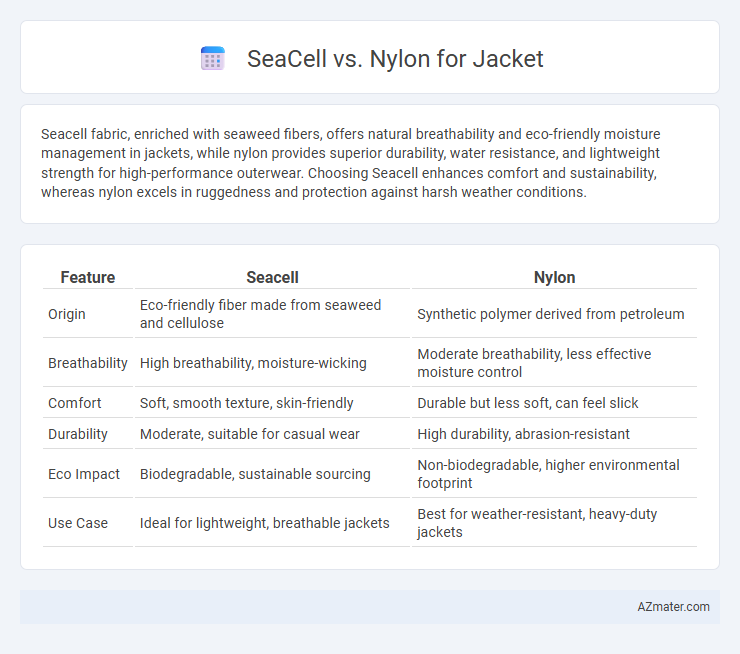Seacell fabric, enriched with seaweed fibers, offers natural breathability and eco-friendly moisture management in jackets, while nylon provides superior durability, water resistance, and lightweight strength for high-performance outerwear. Choosing Seacell enhances comfort and sustainability, whereas nylon excels in ruggedness and protection against harsh weather conditions.
Table of Comparison
| Feature | Seacell | Nylon |
|---|---|---|
| Origin | Eco-friendly fiber made from seaweed and cellulose | Synthetic polymer derived from petroleum |
| Breathability | High breathability, moisture-wicking | Moderate breathability, less effective moisture control |
| Comfort | Soft, smooth texture, skin-friendly | Durable but less soft, can feel slick |
| Durability | Moderate, suitable for casual wear | High durability, abrasion-resistant |
| Eco Impact | Biodegradable, sustainable sourcing | Non-biodegradable, higher environmental footprint |
| Use Case | Ideal for lightweight, breathable jackets | Best for weather-resistant, heavy-duty jackets |
Introduction to Seacell and Nylon Fabric
Seacell fabric, made from cellulose fibers infused with algae extracts, offers natural breathability, moisture-wicking, and skin-friendly properties, making it ideal for eco-conscious jacket manufacturing. Nylon, a synthetic polymer known for its exceptional durability, water resistance, and lightweight characteristics, is widely used in jackets designed for outdoor activities and harsh weather conditions. Both materials serve distinct purposes, with Seacell emphasizing sustainability and comfort, while Nylon prioritizes strength and protection.
Key Characteristics of Seacell
Seacell fabric, derived from seaweed and combined with cellulose fibers, offers exceptional moisture-wicking and natural antibacterial properties, making it a breathable and odor-resistant choice for jackets. Compared to nylon, Seacell provides superior softness and skin-friendly benefits due to its bioactive compounds, while nylon excels in durability and water resistance but lacks the eco-friendly and skin-nourishing attributes of Seacell. Jackets made with Seacell are ideal for those seeking sustainable, comfortable, and functional outerwear with enhanced moisture management and antimicrobial features.
Core Properties of Nylon
Nylon, a synthetic polymer known for its exceptional durability, offers high tensile strength and resistance to abrasion, making it ideal for jackets designed to withstand rough conditions. Its lightweight and moisture-wicking properties provide comfort by efficiently managing sweat and preventing dampness. Nylon also excels in elasticity and quick-drying ability, enhancing mobility and convenience for active wearers.
Comfort and Breathability Comparison
Seacell jackets offer superior comfort and breathability due to their natural fiber composition, which effectively wicks moisture and promotes air circulation, keeping the wearer dry and cool. Nylon jackets, while durable and lightweight, tend to trap heat and moisture, often resulting in less breathability and reduced comfort during extended wear. The biodegradable nature of Seacell combined with its breathable properties makes it a preferred choice for eco-conscious consumers seeking enhanced comfort in outerwear.
Moisture Management and Absorption
Seacell fibers excel in moisture management by naturally absorbing and retaining moisture while promoting breathability, keeping the skin dry and comfortable during physical activities. Nylon offers superior moisture-wicking properties due to its hydrophobic nature, which enables quick evaporation of sweat from the fabric surface, enhancing overall dryness. Compared to nylon, Seacell has better moisture absorption and skin-friendly benefits, whereas nylon outperforms in rapid moisture transfer and durability for jackets.
Durability and Longevity
Seacell fabric, infused with seaweed fibers, offers moderate durability and biodegradability, making it less resistant to abrasion and wear compared to nylon. Nylon excels in jacket construction due to its exceptional tensile strength, abrasion resistance, and long-lasting performance under harsh conditions. Jackets made from nylon typically provide superior longevity, maintaining structural integrity and appearance over extended use, while Seacell jackets prioritize eco-friendly benefits with somewhat reduced durability.
Sustainability and Environmental Impact
Seacell fabric, derived from sustainably harvested seaweed and cellulose fibers, offers significant environmental benefits due to its biodegradability and natural nutrient release during decomposition. Nylon production relies heavily on petrochemicals, contributing to greenhouse gas emissions and non-biodegradability, which poses challenges for waste management. Seacell jackets support eco-friendly fashion initiatives by reducing carbon footprint and promoting circular textile economies, unlike traditional nylon counterparts.
Skin Sensitivity and Hypoallergenic Aspects
Seacell fabric, derived from seaweed fibers, is naturally hypoallergenic and ideal for sensitive skin due to its moisture-regulating and antibacterial properties. Nylon, a synthetic material, may cause irritation or allergic reactions in individuals with sensitive skin because it lacks natural breathability and moisture management. Choosing Seacell over Nylon for jackets supports better skin health by reducing the risk of itching, redness, and allergic responses.
Care, Maintenance, and Ease of Cleaning
Seacell jackets require gentle care, often needing hand washing or delicate machine cycles to preserve the fabric's eco-friendly cellulose fibers and seaweed content, which can degrade under harsh detergents and high heat. Nylon jackets are more resilient, allowing for regular machine washing with standard detergents and quick drying without damage, making them easier to maintain for active use. When comparing ease of cleaning, nylon offers better stain resistance and durability, while Seacell demands more careful handling to maintain its softness and environmental benefits.
Which is Better for Jackets: Seacell or Nylon?
Seacell fabric, derived from natural seaweed fibers, offers superior breathability, moisture-wicking, and eco-friendly benefits compared to nylon, which is synthetic and less sustainable. Nylon excels in durability, water resistance, and lightweight properties, making it suitable for rugged, weatherproof jackets. For jackets prioritizing comfort, skin-friendliness, and environmental impact, Seacell is better, while nylon suits high-performance outerwear demanding strength and water repellency.

Infographic: Seacell vs Nylon for Jacket
 azmater.com
azmater.com